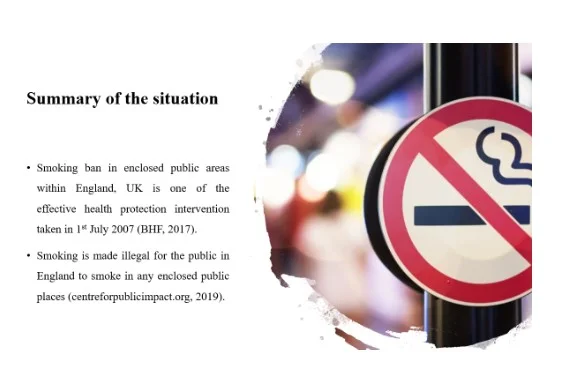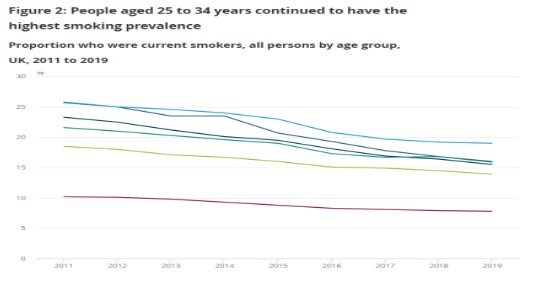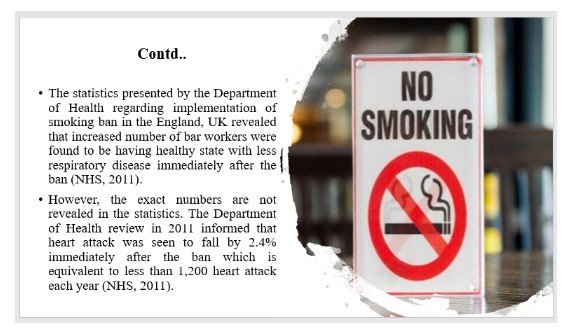Addressing Tobacco Smoking in Public


A public health issue or problem is a medical issue that affects the health of a significant proportion of population that compromises their health and well-being (Farsalinos, 2018). In this presentation, the public health issue of tobacco smoking in the public is to be focused in England, UK. The health protection intervention for tobacco smoking in public taken by England, UK is Smoking ban in public or confined places which is the main focus of discussion in the presentation. For those researching similar topics, healthcare dissertation help can offer valuable insights and support.

The Smoking ban in enclosed public areas within England, UK is one of the effective health protection intervention taken in 1st July 2007 which was already by the time was implemented in Scotland (March, 2006) and in Northern Ireland (April, 2007) (BHF, 2017). According to the intervention, it was made illegal for the public in England to smoke in any enclosed public places such as restaurant, pubs, workplaces and work vehicles, public transport and others. The ban also indicates that smoking is not allowed in personal vehicles if any individual below the age of 18 is present in the care (centreforpublicimpact.org, 2019).
Continue your journey with our comprehensive guide to Tobacco Control Plan for the UK.
The intervention though provided some exemptions such as smoking was allowed to be performed in designated rooms in nursing homes, hotel rooms, prisons, mental health units (until 2008), offshore oil rigs and specialist tobacconists (centreforpublicimpact.org, 2019). The smoking ban was legally challenged in 2010 by the then Coalition government to be reviewed but the appeal was neglected and the ban was continued strictly in all enclosed public places in the UK (BHF, 2017).


The topic of banning tobacco smoking in enclosed public places is addressed by the health protection intervention because smoke and chemicals released from the tobacco in the enclosed places during smoking was creating hindered health consequences to people who are non-smokers. This is evident as the second-hand smoke from the tobacco in the enclosed places was found to be causing non-smokers develop similar health consequences such as cardiovascular diseases, respiratory issues and others (Radó et al., 2020). Moreover, smoking in public places is also focused in the intervention because it would be effective to lead many people leave the habit of smoking out of facing hindrance to smoke freely (Jankowski et al., 2017). In addition, the people suffering from respiratory disease would be safe in enclosed public places as they may not feel chocked or respiratory issues due to presence of secondary smoke from the cigarettes in the surrounding (Lagerweij et al., 2019).

The aim of the study is to assess the impact of smoking ban as health protection intervention from smoking tobacco in England, UK.

In England, UK, after the Smoking Ban intervention it was informed by the government that they found people were trying to quit smoking to avoid facing the banned situation. In order to prove the fact, the data from the government websites and Department of Health review report are to be taken for presentation.
As per data from the General Household Survey, in 2006, 22% of the adults in England, UK were found to be involved in smoking among which 23% were men and 21% were female. It was also reported that 29% of adults were routinely addicted to smoking in England, UK in 2006 (NHS, 2008). However, in 2008, only 1% reduction to 21% in smoking rate among adults was reported in England, UK and the percentage remained same till 2010 (NHS, 2011). In the current condition, it is seen that smoking rate among adults in England, UK has fallen to 14.1% in 2018-19. This is equal to 6.9 million smokers present in the total population of the country. This trends of effective falling of smoking rate among people in England, UK was reported to have been extensively seen from 2011 (NHS, 2019).


The statistics inform that gradual decrease in smoking among adults in England, UK after the ban was seen but it was highly expressed only after 2011. It mentions that only after the smoking ban was proved not to be reviewed or change in any manner, lead the people develop the habit of quitting smoking to avoid legal consequences from the violation of the
intervention. This is evident as a last attempt was found to be taken in 2010 to create relaxation of the smoking ban in private pub and restaurants which were not considered by the government (NHS, 2011). Therefore, after certainty of smoking ban, the adults in England, UK holistically understand they are to change their habit as most smoking are done in public.

In determining the epidemiological data regarding impact of smoking ban in the England, UK as per age, it was seen that the highest reduction in smoking after the ban was reported among people between 18-25 years of age. This is evident as in 2011 it was seen that 25.7% of the people of 18-25 year of age in England, UK are involved in smoking whereas in 2019, 16% of the people of 18-25 years in the age were found to be smoking (NHS, 2011; ONS, 2019).
The smoking ban was effective as more young people are made to avoid smoking in the restaurants which they usually visit to socialise more than the adults. It is evident as 3.4% rise of restaurant visits among the young people below 30 years of age in the UK was reported in 2019 compared to 2.3% of rise of restaurant visits in people over 60 years of age (Varlow, 2019). The young people are considered as the future of the country as they are the individuals who found to implement hard work in better progress of the country (Tyrrell et al., 2019). However, often smoking leads young people to suffer risk of cardiovascular diseases, respiratory issues and other due to smoking. Thiss leads them unable to implement effective hard work from their ability in progress of the economies of the country leading to negative impact the progress of the country (Campbell, 2018). Thus, the decreased smoking rate among young people created by the smoking ban in England, UK was an effective social approach in boosting the health of the young people and improve their ability to invest in upliftment of the country.
Dig deeper into Health Risks of Smoking with our selection of articles.

In between 2005-2015, it is mentioned that nearly 7000 pubs were closed in the UK which were mostly in England (Yiggle, 2017). This is because such pubs allowed high amount of smoking activities to be done compared to other activities. Therefore, smoking ban in the UK was an effective approach in limiting the operation of such business that are eventually harmful for promoting negative health activities of the people.
In a survey by the YouGov, it is seen that 14% of the ex-smokers informed the smoking ban in public enclosed places helped them in quitting smoking and an additional 20% smokers reported they are involved in quitting smoking as a result of the smoking ban created in the England, UK (smokefreeaction.org.uk, 2020). The NHS Stop Smoking services revealed that after the smoking ban, 23% increase in the attempt to quit the habits is seen among adults by them (smokefreeaction.org.uk, 2020; Tiggle, 2017). The increased uptake of initiative among the adults and young people in the UK to quit smoking after the ban indicates that the intervention ha been strictly implemented by the law and greater awareness has been reached regarding the importance of following the ban.

The better health of the bar and restaurant worker after the smoking ban in England led to assess that secondary smoking does act as hindered health consequences for people who are not directly smoking. The study by AlQahtani (2017) mentioned that nicotine present in smoke of the tobacco impact the blood to be thickened and support formation of blood clots that block the flow of the blow through the arteries to the heart for its enhanced functioning. However, the smoking bans in the England, UK revealed that heart diseases were lowered indicating the smoking ban intervention was successful as it is reducing smoking rate as well as improve the health of the people by making them develop less risk towrads fatal heart diseases.

The study concludes that smoking ban is one of the health protection intervention been legally implemented in the England, UK as well as in other parts of the UK. It helped in lowering the smoking rate among people of all age groups country to great extent as well as assisted better health of the people who are directly involved in working operation that exposed them easily to secondary smoke without their consent.

The limitation of the gathered data is that most of the information are presented statistically due to which the exact factors and situation responsible for reduction of smoking rate after the smoking ban was unable to be understood. Moreover, the other limitation of the data is that it failed to inform statistically to the extent the staffs in restaurant and pubs were benefited with the actions.

The recommendation in this respect of the review of the smoking ban in England, UK is that further interview is to be executed to determine the exact situation and causes after the smoking ban that led to such great changes in the smoking prevalent among people of age in the country. This is to understand how the ban was effective in managing the smoking rate situation in England, UK

References
- AlQahtani, J.M., 2017. Knowledge, attitude and practice of tobacco smoking among health colleges' students at Najran University, Saudi Arabia: A cross-sectional descriptive study. Journal of Health Specialties, 5(1), p.35.
- BHF 2017, How has the smoking ban changed our health?, Available at: https://www.bhf.org.uk/informationsupport/heart-matters-magazine/news/smoking-ban [Accessed on: 27 March 2020]
- Campbell, R.B., 2018. " A Sea of Blood and Smoking Ruin": Reflections on Sam Houston and Slavery. Southwestern Historical Quarterly, 122(2), pp.134-142.
- centreforpublicimpact.org 2019, Smoking ban in the United Kingdom, Available at: https://www.centreforpublicimpact.org/case-study/smoking-ban-united-kingdom [Accessed on: 27 March 2020]
- Farsalinos, K., 2018. Electronic cigarettes: an aid in smoking cessation, or a new health hazard?. Therapeutic advances in respiratory disease, 12, p.1753465817744960.
- Jankowski, M., Brozek, G., Lawson, J., Skoczynski, S. and Zejda, J.E., 2017. E-smoking: Emerging public health problem?. International journal of occupational medicine and environmental health, 30(3), p.329.
- Lagerweij, N.A., Kuipers, M.A., Schreuders, M., Grard, A., Mlinarić, M., Richter, M., Leao, T., Kinnunen, J.M. and Kunst, A.E., 2019. The visibility of smoking in Europe and its relationship with youth’s positive beliefs about smoking. International journal of public health, 64(9), pp.1335-1344.
- NHS 2008, Statistics on Smoking - England, 2008, Available at: https://digital.nhs.uk/data-and-information/publications/statistical/statistics-on-smoking/statistics-on-smoking-england-2008 [Accessed on: 27 March 2020]
- NHS 2011, Statistics on Smoking - England, 2011, Available at: https://digital.nhs.uk/data-and-information/publications/statistical/statistics-on-smoking/statistics-on-smoking-england-2011 [Accessed on: 27 March 2020]
- NHS 2019, Statistics on Smoking, England – 2019, Available at: https://digital.nhs.uk/data-and-information/publications/statistical/statistics-on-smoking/statistics-on-smoking-england-2019/part-3-smoking-patterns-in-adults-copy [Accessed on: 27 March 2020]
- ONS 2019, Adult smoking habits in the UK: 2019, Available at: https://www.ons.gov.uk/peoplepopulationandcommunity/healthandsocialcare/healthandlifeexpectancies/bulletins/adultsmokinghabitsingreatbritain/2019#:~:text=In%202019%2C%20the%20proportion%20of,falling%20smoking%20prevalence%20since%202011. [Accessed on: 27 March 2020]
- Radó, M.K., Mölenberg, F.J., Sheikh, A., Millett, C., Bramer, W.M., Burdorf, A., van Lenthe, F.J. and Been, J.V., 2020. Impact of expanding smoke-free policies beyond enclosed public places and workplaces on children’s tobacco smoke exposure and respiratory health: protocol for a systematic review and meta-analysis. BMJ open, 10(10), p.e038234
- smokefreeaction.org.uk 2020, Over half a million more have tried to quit and 2.4 million have cut down, Available at: https://smokefreeaction.org.uk/around-300000-smokers-quitforcovid/ [Accessed on: 27 March 2020]
- Tiggle, N., 2017, Pub smoking ban: 10 charts that show the impact, Available at: https://www.bbc.com/news/health-40444460 [Accessed on: 27 March 2020]
- Tyrrell, N., Sime, D., Kelly, C. and McMellon, C., 2019. Belonging in Brexit Britain: Central and Eastern European 1.5 generation young people's experiences. Population, Space and Place, 25(1), p.e2205.
- Varlow, J., 2019, Savanta’s recent report The Top 100 Most Loved Eating Out Brands 2019 reveals the UK’s most loved dining brand and explores what it takes to become a brand people love, Available at: https://savanta.com/view/young-people-londoners-active-diners/ [Accessed on: 27 March 2020]

Looking for further insights on Addressing the Imbalance between Technology Interaction and Patient Care? Click here.
- 24/7 Customer Support
- 100% Customer Satisfaction
- No Privacy Violation
- Quick Services
- Subject Experts



